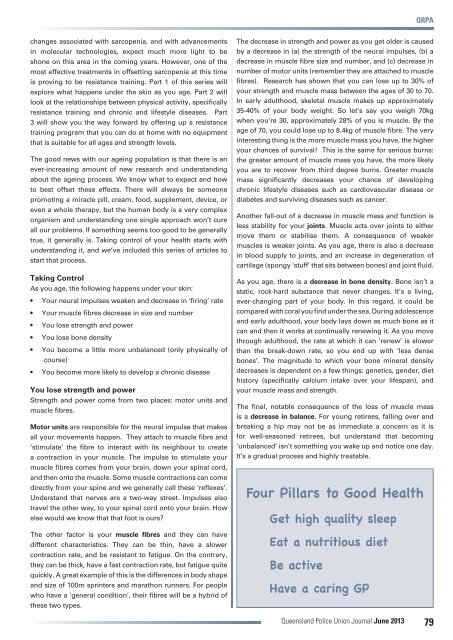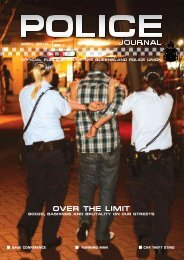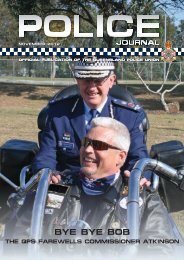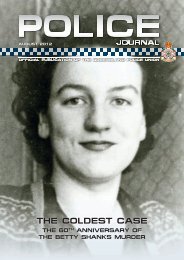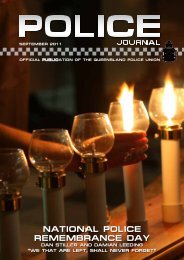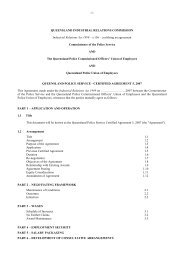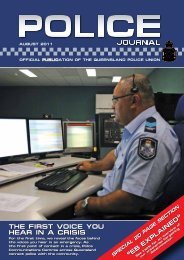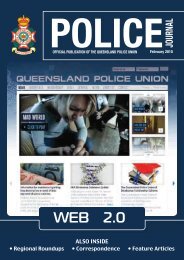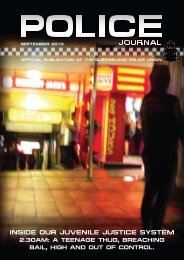Queensland Police Union Journal
Queensland Police Union Journal
Queensland Police Union Journal
Create successful ePaper yourself
Turn your PDF publications into a flip-book with our unique Google optimized e-Paper software.
QRPA<br />
changes associated with sarcopenia, and with advancements<br />
in molecular technologies, expect much more light to be<br />
shone on this area in the coming years. However, one of the<br />
most effective treatments in offsetting sarcopenia at this time<br />
is proving to be resistance training. Part 1 of this series will<br />
explore what happens under the skin as you age. Part 2 will<br />
look at the relationships between physical activity, specifically<br />
resistance training and chronic and lifestyle diseases. Part<br />
3 will show you the way forward by offering up a resistance<br />
training program that you can do at home with no equipment<br />
that is suitable for all ages and strength levels.<br />
The good news with our ageing population is that there is an<br />
ever-increasing amount of new research and understanding<br />
about the ageing process. We know what to expect and how<br />
to best offset these effects. There will always be someone<br />
promoting a miracle pill, cream, food, supplement, device, or<br />
even a whole therapy, but the human body is a very complex<br />
organism and understanding one single approach won’t cure<br />
all our problems. If something seems too good to be generally<br />
true, it generally is. Taking control of your health starts with<br />
understanding it, and we’ve included this series of articles to<br />
start that process.<br />
Taking Control<br />
As you age, the following happens under your skin:<br />
• Your neural impulses weaken and decrease in ‘firing’ rate<br />
• Your muscle fibres decrease in size and number<br />
• You lose strength and power<br />
• You lose bone density<br />
• You become a little more unbalanced (only physically of<br />
course)<br />
• You become more likely to develop a chronic disease<br />
You lose strength and power<br />
Strength and power come from two places: motor units and<br />
muscle fibres.<br />
Motor units are responsible for the neural impulse that makes<br />
all your movements happen. They attach to muscle fibre and<br />
‘stimulate’ the fibre to interact with its neighbour to create<br />
a contraction in your muscle. The impulse to stimulate your<br />
muscle fibres comes from your brain, down your spinal cord,<br />
and then onto the muscle. Some muscle contractions can come<br />
directly from your spine and we generally call these ‘reflexes’.<br />
Understand that nerves are a two-way street. Impulses also<br />
travel the other way, to your spinal cord onto your brain. How<br />
else would we know that that foot is ours?<br />
The other factor is your muscle fibres and they can have<br />
different characteristics. They can be thin, have a slower<br />
contraction rate, and be resistant to fatigue. On the contrary,<br />
they can be thick, have a fast contraction rate, but fatigue quite<br />
quickly. A great example of this is the differences in body shape<br />
and size of 100m sprinters and marathon runners. For people<br />
who have a ‘general condition’, their fibres will be a hybrid of<br />
these two types.<br />
The decrease in strength and power as you get older is caused<br />
by a decrease in (a) the strength of the neural impulses, (b) a<br />
decrease in muscle fibre size and number, and (c) decrease in<br />
number of motor units (remember they are attached to muscle<br />
fibres). Research has shown that you can lose up to 30% of<br />
your strength and muscle mass between the ages of 30 to 70.<br />
In early adulthood, skeletal muscle makes up approximately<br />
35-40% of your body weight. So let’s say you weigh 70kg<br />
when you’re 30, approximately 28% of you is muscle. By the<br />
age of 70, you could lose up to 8.4kg of muscle fibre. The very<br />
interesting thing is the more muscle mass you have, the higher<br />
your chances of survival! This is the same for serious burns:<br />
the greater amount of muscle mass you have, the more likely<br />
you are to recover from third degree burns. Greater muscle<br />
mass significantly decreases your chance of developing<br />
chronic lifestyle diseases such as cardiovascular disease or<br />
diabetes and surviving diseases such as cancer.<br />
Another fall-out of a decrease in muscle mass and function is<br />
less stability for your joints. Muscle acts over joints to either<br />
move them or stabilise them. A consequence of weaker<br />
muscles is weaker joints. As you age, there is also a decrease<br />
in blood supply to joints, and an increase in degeneration of<br />
cartilage (spongy ‘stuff’ that sits between bones) and joint fluid.<br />
As you age, there is a decrease in bone density. Bone isn’t a<br />
static, rock-hard substance that never changes. It’s a living,<br />
ever-changing part of your body. In this regard, it could be<br />
compared with coral you find under the sea. During adolescence<br />
and early adulthood, your body lays down as much bone as it<br />
can and then it works at continually renewing it. As you move<br />
through adulthood, the rate at which it can ‘renew’ is slower<br />
than the break-down rate, so you end up with ‘less dense<br />
bones’. The magnitude to which your bone mineral density<br />
decreases is dependent on a few things: genetics, gender, diet<br />
history (specifically calcium intake over your lifespan), and<br />
your muscle mass and strength.<br />
The final, notable consequence of the loss of muscle mass<br />
is a decrease in balance. For young retirees, falling over and<br />
breaking a hip may not be as immediate a concern as it is<br />
for well-seasoned retirees, but understand that becoming<br />
‘unbalanced’ isn’t something you wake up and notice one day.<br />
It’s a gradual process and highly treatable.<br />
Four Pillars to Good Health<br />
Get high quality sleep<br />
Eat a nutritious diet<br />
Be active<br />
Have a caring GP<br />
<strong>Queensland</strong> <strong>Police</strong> <strong>Union</strong> <strong>Journal</strong> June 2013<br />
79


